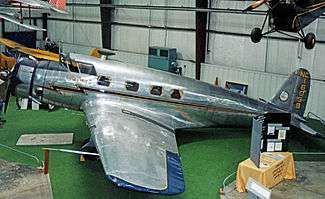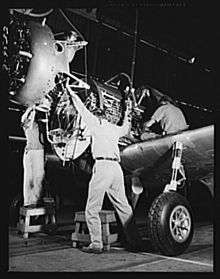Vultee Aircraft
| Fate | Merged with Consolidated Aircraft to form Consolidated Vultee Aircraft Corporation |
|---|---|
| Predecessor |
Airplane Development Corporation (1932−1934), AVCO Aviation Manufacturing Corporation (1934−1939) |
| Successor | Convair |
| Founded | 1939 |
| Founder | Gerard Vultee and Vance Breese |
| Defunct | 1943 |
| Headquarters |
Downey, Los Angeles County, California |
The Vultee Aircraft Corporation became an independent company in 1939 in Los Angeles County, California. It had limited success before merging with the Consolidated Aircraft Corporation in 1943, to form the Consolidated Vultee Aircraft Corporation − or Convair.[1]
History

Gerard "Jerry" Freebairn Vultee (1900–1938) and Vance Breese (1904–1973) started the Airplane Development Corporation in early 1932 after American Airlines showed great interest in their six-passenger V-1 design. Soon after, Errett Lobban (E.L.) Cord bought all 500 shares of stock in the company and the Airplane Development Corporation became a Cord subsidiary.
AVCO subsidiary
Due to the Air Mail Act of 1934, AVCO established the Aviation Manufacturing Corporation (AMC) on November 30, 1934 through the acquisition of Cord's holdings, including Vultee's Airplane Development Corporation. AMC was liquidated on January 1, 1936 and Vultee Aircraft Division was formed as an autonomous subsidiary of AVCO.
Jerry Vultee was named vice president and chief engineer.[2] Vultee acquired the assets of the defunct AMC, including Lycoming Engines and Stinson Aircraft Company.
Meanwhile, Vultee and Breese had redesigned the V-1 to meet American Airlines' needs and created the eight-passenger V-1A. American purchased 11 V-1As, but the plane ultimately failed due to safety concerns about a single-engine plane and the advent of the twin-engine Douglas DC-2s and DC-3s. Vultee redesigned the V-1 into the V-11 attack aircraft for the United States Army Air Corps, but it received few initial orders.
By 1937 Jerry was heading his own factory in Downey, California with more than a million dollars in orders for V-1s, V-1As and V-11s.[2]
In 1938, before he could see Vultee become an independent company, Jerry Vultee and his wife Sylvia Parker, the daughter of Twentieth Century Fox movie director Max Parker,[2] died when the plane he was piloting crashed in a snowstorm near Sedona, Arizona. A bronze plaque memorializing the Vultees is located at the end of Coconino Forestry trail named in honor of Vultee Arch, a natural rock arch near the site of the plane crash near Sedona, Arizona. It is reached via a 5-mile jeep trail, followed by a 2-mile hike (one way) on a well-used trail. The Vultee Arch Trail goes to a viewpoint for the arch.[3] Donald P. Smith, Jerry Vultee's close friend and Vice President of Vultee Aircraft, wrote a letter to TIME magazine about Jerry's death:
Sirs:
- ''Gerard F. Vultee ("Jerry"), not Gerald, my close friend and business associate for many years, was killed when the cabin monoplane he was flying with Mrs. Vultee crashed on the flat top of Wilson Mountain [TIME, Feb. 7]. ... Caught in a local snow-storm and blizzard with no training in blind or instrument flying, he was unable to find his way out. The fire occurred after the crash, not before.
- DON P. SMITH Vice President
- Vultee Aircraft Los Angeles, Calif.[4]

AVCO hired Dick Palmer away from Howard Hughes to take Jerry Vultee's place, and Vultee Aircraft Division began to develop military designs. Dick Palmer created the BT-13, BT-15, and SNV Valiant trainers[2] and oversaw other major production program such as the V-72 Vengeance, serving in the USAAC as the A-31 and A-35.
Independent company
Vultee Aircraft was created in November 1939, when Vultee Aircraft Division of AVCO was reorganized as an independent company.[6][2]
The P-66 Vanguard was a 1941 fighter program that was intended for Sweden that was inherited by the USAAC, Great Britain and finally, China. The P-66 had a mediocre combat record in China and was out of service by 1943. The XP-54 fighter project was the last Vultee Aircraft design, but only two examples were built.[7][8][9]
Vultee was the first company to build aircraft on a powered assembly line, and the first to use women workers in production-line positions.
Merger
On March 17, 1943, Consolidated and Vultee officially merged, creating Consolidated Vultee Aircraft Corporation, popularly known as Convair.[10] The Vultee management resigned.[9][11]
Vultee timeline
- 1929 Aviation Corporation (AVCO) holding company formed by multiple participants
- 1932 Airplane Development Corporation formed by Gerard F. "Jerry" Vultee; Errett Lobban Cord soon takes it over
- 1934 AVCO acquired the Airplane Development Corporation from Cord and formed the Aviation Manufacturing Corporation (AMC)
- 1936 AMC liquidated to form the Vultee Aircraft Division, an autonomous subsidiary of AVCO
- 1939 Vultee Aircraft Division of AVCO reorganized as an independent company known as Vultee Aircraft, Inc.
- 1941 Consolidated Aircraft Corporation sold to AVCO
- 1943 Consolidated Vultee Aircraft Corporation, generally known as Convair, formed by the merger of Consolidated Aircraft and Vultee Aircraft; still controlled by AVCO
- 1947 Convair acquired by the Atlas Corporation
- 1953 (or 1954) Convair acquired by General Dynamics
- 1985 General Dynamics formed the "Space Systems Division" from the Convair Space Program
- 1993 Lockheed Corporation acquires General Dynamics' Fort Worth aircraft division, builder of the F-16 Fighting Falcon.
- 1994 Space Systems Division sold to Martin Marietta
- 1994 Convair Aircraft Structures unit sold to McDonnell Douglas
Aircraft
- Vultee A-31 Vengeance
- Vultee XA-41
- Vultee BT-13 Valiant
- Vultee XP-54
- Vultee P-66 Vanguard
- Vultee XP-68 Tornado
- Vultee V-1
- Vultee V-11
References
Notes
- ↑ "Vultee." centennialofflight.net, 2003. Retrieved: 26 August 2010.
- 1 2 3 4 5 Yenne 2009, p. 17.
- ↑ "Coconino National Forest." USDA Forest Service. Retrieved: 26 August 2010.
- ↑ "Davis-Monthan Field Register." dmairfield.com. Retrieved: 26 September 2010
- ↑ Parker, Dana T. Building Victory: Aircraft Manufacturing in the Los Angeles Area in World War II, pp. 107, 110-13, Cypress, CA, 2013. ISBN 978-0-9897906-0-4.
- ↑ Parker, Dana T. Building Victory: Aircraft Manufacturing in the Los Angeles Area in World War II, pp. 107-120, Cypress, CA, 2013.
- ↑ Herman, Arthur. Freedom's Forge: How American Business Produced Victory in World War II, pp. 140, 203, 262-3, Random House, New York, NY, 2012.
- ↑ Parker, Dana T. Building Victory: Aircraft Manufacturing in the Los Angeles Area in World War II, pp. 107-120, Cypress, CA, 2013. ISBN 978-0-9897906-0-4.
- 1 2 Borth, Christy. Masters of Mass Production, p. 251, Bobbs-Merrill Co., Indianapolis, IN, 1945.
- ↑ Yenne 2009, p. 18.
- ↑ Parker, Dana T. Building Victory: Aircraft Manufacturing in the Los Angeles Area in World War II, p. 114, Cypress, CA, 2013.
Bibliography
- McKillop, Jack. "Vultee SNV Valiant." Brown-Shoe Navy: U.S. Naval Aviation. Retrieved: January 6, 2006.
- Parker, Dana T. Building Victory: Aircraft Manufacturing in the Los Angeles Area in World War II, Cypress, CA, 2013. ISBN 978-0-9897906-0-4.
- Rumerman, Joel. "Consolidated Vultee Aircraft Corporation." US Centennial of Flight Commission, 2003. Retrieved: January 6, 2006.
- Thompson, Jonathan. Vultee Aircraft 1932–1947. Santa Ana, CA; Narkiewicz/Thompson, 1992. ISBN 0-913322-02-4.
- "The Vultee V-1A" Golden Age of Aviation E-column, Retrieved: 6 January 2006.
- Yenne, Bill. Convair Deltas from Sea Dart to Hustler. North Branch, MN: Specialty Press, 2009. ISBN 978-1-58007-118-5.
External links
- Info & Fotos of various Vultee Aircraft.
- Additional info & fotos about Jerry Vultee & Vultee Aircraft.
- Textron Lycoming Turbine Engine, a Company History of AVCO and Lycoming/Textron
- Avco Financial Services, Inc. from the Lehman Brothers Collection – Twentieth Century Business Archives
- Consolidated Vultee Aircraft Corporation, U.S. Centennial of Flight Commission
- General Dynamics Corporation, U.S. Centennial of Flight Commission
- Central Manufacturing Co. of Connersville, Indiana, a history of Cord, AVCO, and others
| Wikimedia Commons has media related to Vultee aircraft. |